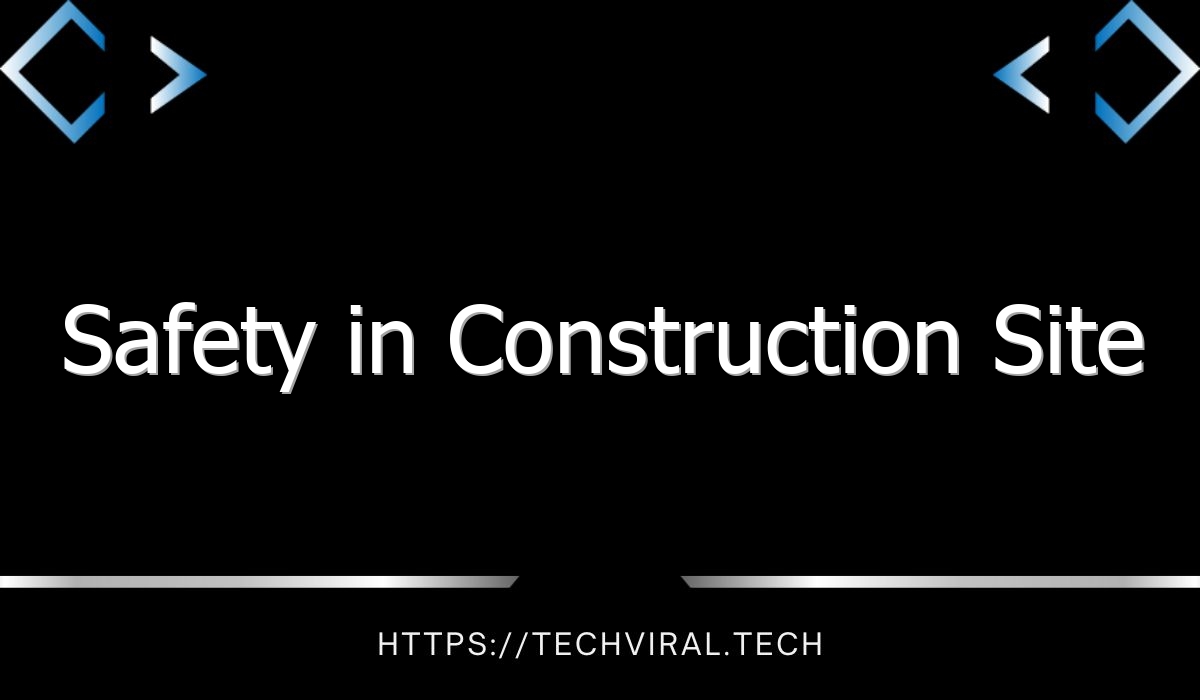Safety in Construction Site
Safety in Construction site is a critical aspect of a construction project. It helps to protect workers and the public from any possible health risks. A construction site must be safe for everyone, including contractors, subcontractors and workers. By following proper safety procedures, you can avoid a variety of health problems and injury hazards. This article will discuss the various ways to ensure that the site is safe. You can also use risk assessments to make sure you’re avoiding a potentially harmful situation.
Building a chain of command for safety
The chain of command is a powerful tool to ensure that employees are safe. This system allows workers to communicate freely with their supervisors and leaders. It also shows workers that they play an important role in job site safety. The more they feel they are supported by their employer, the more likely they are to report concerns and share information. This two-way communication will also help foster a culture of safety.
As a leader, it is your job to establish a safety culture in your company. This includes providing resources, empowering employees, and educating your organization’s workforce. This will help you build a stronger safety culture and ensure that all employees feel engaged and comfortable in their role.
Building a chain of command is essential to the safety of your construction site. Employees should be able to speak with the site superintendent whenever they have concerns or questions. This way, they can get immediate answers to any questions or safety concerns they may have. In addition, a documented chain of command will help you address safety concerns quickly.
As a leader, you should follow your safety plan at all times. Laxity on safety can lead to poor practices and disastrous outcomes. Remember that as a company, you also have a responsibility to deliver results, meet deadlines, and deliver the products and services that you promised. Safety and productivity are increasingly interconnected. Many companies are realizing that these two are part of the same machine.
As the construction industry continues to develop, the importance of health and hygiene has become even more important. Many sites and businesses have started new initiatives to address these issues, including implementing new PPE and offering counselors. One construction company even gives out custom poker chips with a mental health hotline number for workers to call. This hotline is available 24 hours a day. This initiative shows that the construction industry is taking mental health seriously.
Occupational safety
Occupational safety on a construction site means following the safety procedures to avoid accidents and injuries. All employees should be trained about safety practices. They should also wear appropriate personal protective equipment, which includes protective clothing, gloves and paraphernalia. Such items should be inspected regularly and should not be damaged or removed when not in use.
One of the most common hazards on a construction site is slips, trips and falls. These types of injuries account for a high percentage of non-fatal accidents in the US and UK. To minimize these types of injuries, site management must keep walkways and equipment secure. In addition, workers should wear PPE and attend regular safety meetings.
In the past decade, occupational safety and health has become a hot topic. Many construction professionals have become aware of the hazards on a construction site and the measures to prevent them. However, despite knowledge about the risks, occupational accidents and illnesses continue to occur. Research has been carried out to determine how to protect workers from these hazards and prevent them.
Achieving zero workplace fatalities is an industry goal, and it takes a lot of effort and education to get there. Awareness about workplace hazards is vital to the health and safety of construction workers. Training workers, communication about safety issues, and documentation of safety issues are all crucial to achieving this goal. Proper supervision, proper equipment, and innovative solutions to problems are other essential aspects of safety in the construction site.
Occupational safety on a construction site is a major concern, but most of the research in this field focuses on the construction phase. Several authors have studied different approaches to improving safety on a construction site. For example, Hinze studied human behavior as a means to reduce risk. In another study, Chi and Han looked at 9,358 accidents in the U.S. construction industry between 2002 and 2011. Their results suggested that risk management strategies must be designed to reduce accidents and incidents on construction sites.
Fire prevention
In construction sites, fire prevention is a necessity to ensure the safety of workers and contractors. General fire precautions include identifying flammable materials and equipment, escape routes, exits, and raising the alarm, and emergency plans. It is also important to document where employees will store their materials. In addition, fire-fighting equipment should be accessible, with hose connections placed close to construction areas.
The construction site should be inspected regularly to assess hazards and facilitate the access of firefighters. Fire prevention in construction sites also includes ensuring that electrical systems are installed and regularly maintained. Moreover, workers should be educated on how to prevent fires and firefighter safety. Lastly, temporary heaters and waste packaging should be placed away from flammable materials.
In 2013, the National Fire Protection Association reported that 3,840 construction-related fires were reported each year. The fires caused 49 civilian injuries and a total of $304 million in property damage. Identifying hazards early will help project managers minimize fire risks and avoid expensive delays. NFPA has a number of resources to help construction site managers learn more about safety hazards. In addition, the NFPA 241 standard can help construction managers implement fire safety measures.
In addition to fire prevention, tight security is also important to prevent vandalism and arson. Proper perimeter fencing can protect materials and equipment. In addition, a high-quality security system provides 24-hour monitoring of the construction site. It is important to remember that fire safety is not just about having the appropriate equipment and training – it is also essential to understand the requirements of the regulations and follow them.
Fire prevention in construction sites must be part of a site’s induction process for new operatives. Workers must be trained in the plan and know where to locate fire extinguishers and exit routes. Fire prevention rules should be explained to all employees during inductions and on a regular basis during toolbox talks. If waste materials block escape routes, site management should address these hazards as soon as possible.
Health and safety risk assessments
Health and safety risk assessments are essential to ensure the health and safety of workers. They are also a legal requirement. Occupational health service providers and employers need to work together to identify the risks to workers. Health and safety risk assessments help employers make informed decisions about the level of protection their employees require.
In construction, occupational risks are common. In fact, the Health and Safety Executive (HSE) reported that there were 61,000 accidents on construction sites last year, including 40 fatalities. This is why it’s so important for employers to undertake risk assessments, which identify all sources of danger in their field of work. Then, they can implement the right control measures to keep workers safe.
If you’re unsure how to make a health and safety risk assessment, you can consult the HSE. HSE regulations stipulate that certain kinds of accidents must be reported, including fatal and injury incidents. You can also consult the records of previous jobs to see what controls were in place to prevent them.
A risk analysis should take into account normal and unusual operating conditions. The severity and frequency of a risk should be considered, and any required controls should be determined based on these factors. Then, the risk assessment must take into account any back-up plans that can be put into place. It’s a good idea to involve a team of people in the process of identifying potential risks. They’re knowledgeable about the area where work is done and can provide a fresh perspective.
A comprehensive risk assessment should include all risks at a construction site. This includes building hazards, equipment, tools, materials, activities, heights, heat, manual handling, and visiting professionals. It’s also important to consider the public’s safety.
Employee assistance programs
An Employee Assistance Program (EAP) can reduce the stress of employees on the job, improve their performance, and improve their overall health. These programs come in a variety of sizes and can be managed in-house or outsourced. Some focus on a single organization, while others serve a number of smaller businesses. They can help to reduce employee turnover, which costs the company money and lowers revenue.
Employee assistance programs (EAPs) are an essential part of a caring work environment. They demonstrate the employer’s concern for the well-being of its employees and their families. They also promote a healthy work-life balance, and help address suicide prevention and mental health in the workplace.
Employee Assistance Programs can also help reduce turnover. These programs can cost just a few dollars per month and may be cheaper than hiring new employees. Some programs even offer marital counseling and family counseling services. It is essential to choose a program that prioritizes the quality of its services over the price.
An EAP can help an employee deal with personal issues that may be affecting his or her productivity. These programs can be designed to identify and address a wide variety of problems, from work/life balance to substance use. Some programs focus on prescription drugs and alcohol while others focus on mental health issues.
A supportive environment is essential for productivity. Employees need to feel safe and secure to share personal issues. By creating an environment where they feel safe, employee assistance programs help improve employee morale and productivity. These programs can also reduce absenteeism.




